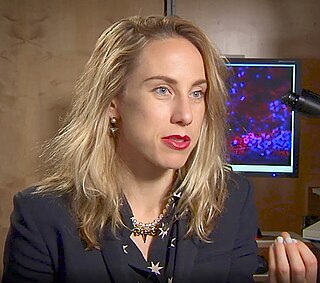Nanomedicine is the medical application of nanotechnology. Nanomedicine ranges from the medical applications of nanomaterials and biological devices, to nanoelectronic biosensors, and even possible future applications of molecular nanotechnology such as biological machines. Current problems for nanomedicine involve understanding the issues related to toxicity and environmental impact of nanoscale materials.

Quantum dots (QDs) or semiconductor nanocrystals are semiconductor particles a few nanometres in size with optical and electronic properties that differ from those of larger particles via quantum mechanical effects. They are a central topic in nanotechnology and materials science. When a quantum dot is illuminated by UV light, an electron in the quantum dot can be excited to a state of higher energy. In the case of a semiconducting quantum dot, this process corresponds to the transition of an electron from the valence band to the conductance band. The excited electron can drop back into the valence band releasing its energy as light. This light emission (photoluminescence) is illustrated in the figure on the right. The color of that light depends on the energy difference between the conductance band and the valence band, or the transition between discrete energy states when the band structure is no longer well-defined in QDs.

Nanoid robotics, or for short, nanorobotics or nanobotics, is an emerging technology field creating machines or robots, which are called nanorobots or simply nanobots, whose components are at or near the scale of a nanometer. More specifically, nanorobotics refers to the nanotechnology engineering discipline of designing and building nanorobots with devices ranging in size from 0.1 to 10 micrometres and constructed of nanoscale or molecular components. The terms nanobot, nanoid, nanite, nanomachine and nanomite have also been used to describe such devices currently under research and development.

A nanomotor is a molecular or nanoscale device capable of converting energy into movement. It can typically generate forces on the order of piconewtons.
A selenide is a chemical compound containing a selenium with oxidation number of −2. Similar to sulfide, selenides occur both as inorganic compounds and as organic derivatives, which are called organoselenium compound.

James Mitchell Tour is an American chemist and nanotechnologist. He is a Professor of Chemistry, Professor of Materials Science and Nanoengineering at Rice University in Houston, Texas.

Nanochemistry is an emerging sub-discipline of the chemical and material sciences that deals with the development of new methods for creating nanoscale materials. The term "nanochemistry" was first used by Ozin in 1992 as 'the uses of chemical synthesis to reproducibly afford nanomaterials from the atom "up", contrary to the nanoengineering and nanophysics approach that operates from the bulk "down"'. Nanochemistry focuses on solid-state chemistry that emphasizes synthesis of building blocks that are dependent on size, surface, shape, and defect properties, rather than the actual production of matter. Atomic and molecular properties mainly deal with the degrees of freedom of atoms in the periodic table. However, nanochemistry introduced other degrees of freedom that controls material's behaviors by transformation into solutions. Nanoscale objects exhibit novel material properties, largely as a consequence of their finite small size. Several chemical modifications on nanometer-scaled structures approve size dependent effects.

Harry Albert Atwater, Jr. is an American physicist and materials scientist and is the Otis Booth Leadership Chair of the division of engineering and applied science at the California Institute of Technology. Currently he is the Howard Hughes Professor of Applied Physics and Materials Science and the director for the Liquid Sunlight Alliance (LiSA), a Department of Energy Hub program for solar fuels. Atwater's scientific effort focuses on nanophotonic light-matter interactions and solar energy conversion. His current research in energy centers on high efficiency photovoltaics, carbon capture and removal, and photoelectrochemical processes for generation of solar fuels. His research has resulted in world records for solar photovoltaic conversion and photoelectrochemical water splitting. His work also spans fundamental nanophotonic phenomena, in plasmonics and 2D materials, and also applications including active metasurfaces and optical propulsion.
Magnetolithography (ML) is a photoresist-less and photomaskless lithography method for patterning wafer surfaces. ML based on applying a magnetic field on the substrate using paramagnetic metal masks named "magnetic mask" placed on either topside or backside of the wafer. Magnetic masks are analogous to a photomask in photolithography, in that they define the spatial distribution and shape of the applied magnetic field. The fabrication of the magnetic masks involves the use of conventional photolithography and photoresist however. The second component of the process is ferromagnetic nanoparticles that are assembled over the substrate according to the field induced by the mask which blocks its areas from reach of etchants or depositing materials.
Nanofluidic circuitry is a nanotechnology aiming for control of fluids in nanometer scale. Due to the effect of an electrical double layer within the fluid channel, the behavior of nanofluid is observed to be significantly different compared with its microfluidic counterparts. Its typical characteristic dimensions fall within the range of 1–100 nm. At least one dimension of the structure is in nanoscopic scale. Phenomena of fluids in nano-scale structure are discovered to be of different properties in electrochemistry and fluid dynamics.

Core–shell semiconducting nanocrystals (CSSNCs) are a class of materials which have properties intermediate between those of small, individual molecules and those of bulk, crystalline semiconductors. They are unique because of their easily modular properties, which are a result of their size. These nanocrystals are composed of a quantum dot semiconducting core material and a shell of a distinct semiconducting material. The core and the shell are typically composed of type II–VI, IV–VI, and III–V semiconductors, with configurations such as CdS/ZnS, CdSe/ZnS, CdSe/CdS, and InAs/CdSe Organically passivated quantum dots have low fluorescence quantum yield due to surface related trap states. CSSNCs address this problem because the shell increases quantum yield by passivating the surface trap states. In addition, the shell provides protection against environmental changes, photo-oxidative degradation, and provides another route for modularity. Precise control of the size, shape, and composition of both the core and the shell enable the emission wavelength to be tuned over a wider range of wavelengths than with either individual semiconductor. These materials have found applications in biological systems and optics.
Graphene quantum dots (GQDs) are graphene nanoparticles with a size less than 100 nm. Due to their exceptional properties such as low toxicity, stable photoluminescence, chemical stability and pronounced quantum confinement effect, GQDs are considered as a novel material for biological, opto-electronics, energy and environmental applications.

Carbon quantum dots also commonly called carbon nano dots or simply carbon dots are carbon nanoparticles which are less than 10 nm in size and have some form of surface passivation.
Quantum dots (QDs) are semiconductor nanoparticles with a size less than 10 nm. They exhibited size-dependent properties especially in the optical absorption and the photoluminescence (PL). Typically, the fluorescence emission peak of the QDs can be tuned by changing their diameters. So far, QDs were consisted of different group elements such as CdTe, CdSe, CdS in the II-VI category, InP or InAs in the III-V category, CuInS2 or AgInS2 in the I–III–VI2 category, and PbSe/PbS in the IV-VI category. These QDs are promising candidates as fluorescent labels in various biological applications such as bioimaging, biosensing and drug delivery.
Shuming Nie is a Chinese-American chemist. He is the Grainger Distinguished Chair in Bioengineering at the University of Illinois at Urbana-Champaign. He was the Wallace H. Coulter Distinguished Faculty Chair in Biomedical Engineering at Emory University. In 2007, Nie was elected as a fellow of the American Institute for Medical and Biological Engineering (AIMBE). In 2012, Nie was elected as a fellow of the American Association for the Advancement of Science (AAAS).

Vicki Leigh Colvin is a professor of engineering and molecular pharmacology at Brown University, and has been selected as the next dean of the Louisiana State University College of Engineering. At Brown, she is the director of the Centre for Biomedical Engineering. Her work focuses on the synthesis and characterization of nanomaterials. She is a Fellow of the American Association for the Advancement of Science and the American Institute for Medical and Biological Engineering.

Maiken Mikkelsen is a physicist who won the Maria Goeppert Mayer award from the American Physical Society in 2017 for her work in quantum nanophotonics. She is currently the James N. and Elizabeth H. Barton Associate Professor of Electrical and Computer Engineering and an associate professor of physics at Duke University where she teaches ECE 891: internship and ECE 524: introduction to solid state physics. Mikkelsen is credited for many advancements in optoelectronics, nanophotonics, human health and the environment.

Polina Olegovna Anikeeva is a Russian-born American materials scientist who is a Professor of Material Science & Engineering as well as Brain & Cognitive Sciences at the Massachusetts Institute of Technology (MIT). She also holds faculty appointments in the McGovern Institute for Brain Research and Research Laboratory of Electronics at MIT. Her research is centered on developing tools for studying the underlying molecular and cellular bases of behavior and neurological diseases. She was awarded the 2018 Vilcek Foundation Prize for Creative Promise in Biomedical Science, the 2020 MacVicar Faculty Fellowship at MIT, and in 2015 was named a MIT Technology Review Innovator Under 35.
Silicon quantum dots are metal-free biologically compatible quantum dots with photoluminescence emission maxima that are tunable through the visible to near-infrared spectral regions. These quantum dots have unique properties arising from their indirect band gap, including long-lived luminescent excited-states and large Stokes shifts. A variety of disproportionation, pyrolysis, and solution protocols have been used to prepare silicon quantum dots, however it is important to note that some solution-based protocols for preparing luminescent silicon quantum dots actually yield carbon quantum dots instead of the reported silicon. The unique properties of silicon quantum dots lend themselves to an array of potential applications: biological imaging, luminescent solar concentrators, light emitting diodes, sensors, and lithium-ion battery anodes.
Teresa Pellegrino is an Italian chemist who is Professor of Chemistry at the Istituto Italiano di Tecnologia. Her research considers nanomaterials for biomedical applications. She was appointed Associate Editor of Nanoscale in 2022.











